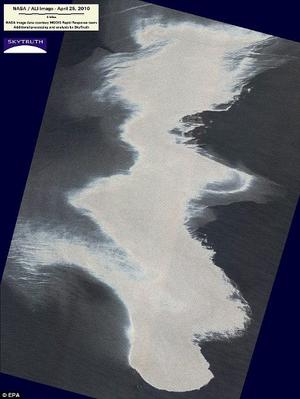Gulf of Mexico oil spillThe bad news: Expect about 38,000,000 gallons of oil to be released into the Gulf
The 1989 Exxon Valdez spilled 10.8 million gallons of oil into Alaska’s Prince William Sound; the Deepwater Horizon rig, which exploded on 20 April, has already released an estimated 9 million gallons of oil into the Gulf; this means that the well releases between 10,000 and 15,000 barrel of oil into the water (there are 42 gallons in a barrel of oil); BP says it will take about three months to cap the underwater gusher — meaning that we should expect the equivalent of 900,000 barrels, or 37,800,000 gallons, to released into the water yet

Satellite image of Gulf of Mexico oil slick // Source: dailymail.co.uk
We are not sure how many of our readers have heard of the Loop Current. For those who have not: the loop Current, which is part of the Gulf Stream, is a warm ocean current in the Gulf of Mexico that flows northward between Cuba and the Yucatán peninsula, moves north into the Gulf of Mexico, loops west and south before exiting to the east through the Florida Straits.
Now, to understand the likely impact of the spill, you may want to see the modeling done by Robert Weisberg, a University of South Florida physical oceanographer who has a Web site where he tracks the spill and the currents of the Gulf and predicts what will happen next..
Joel Achenbach writes in the Washington Post’s Achenblog that the good news is that Sanibel is safe! Also Captiva, and Cedar Key, and St. Petersburg beach, and Longboat Key, and all those other great beaches on the west coast of Florida. Under the Weisberg scenario, the oil is conveyed in deep water, beyond the continental shelf, which extends very far from the west coast of Florida. In fact, the shelf is as wide as the state. It is only when the oil hits the western opening to the Straits of Florida (also known as the Florida Strait) that it comes close to land, and then it shoots up past Miami and Palm Beach and rides the Gulf Stream to Hatteras and, perhaps, all the way to England.
Achenbach says he is pessimistic. Here are excerpts from his fairly ominous story posted yesterday:
“The urgent question in the polluted Gulf of Mexico: How bad will this get?” Achenbach asks. “No one knows, but with each day, as the leaking oil well a mile deep remains uncapped, industry observers and scientists are crafting scenarios that range from bad to worse to worst, with some forecasting a calamity of historic proportions.”
He quotes scientists who said Tuesday that the “loop current” of the gulf, a powerful conveyor belt that extends some 3,000 feet deep, will almost surely take the oil down through the eastern gulf to the Florida Straits between the Keys and Cuba. The oil would then ride the Florida Current directly into the Gulf Stream, which could carry it up the East Coast to Cape Hatteras and beyond, the scientists said.
“I think it is inevitable at this stage because we’re seeing it creep
